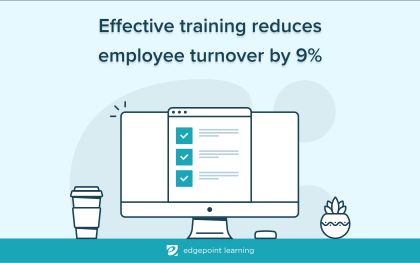How To Start Your Restaurant Managers Training Program
Steve Pruniski
🍿 5 min. read
You know restaurants don’t run themselves; here’s how to train your people to run them even better with a dedicated restaurant managers training program.
Why is a restaurant managers training program so important?
Managing an office setting and managing a restaurant are two different animals. While managers use similar skills in both settings, the moving parts are very different.
For one, your restaurant manager training program needs to acknowledge that not all of your managers come to the position with a lot of restaurant experience. In a perfect hire, your new manager worked their way up through the chain of command – from dishwasher to manager – but this isn’t always the case.
How does this potential inexperience translate into your bottom line?
- Higher turnover: Public Personnel Management found that effective training reduced employee turnover by 9%. While this figure may seem low, consider the average cost to train a new manager: $30,000. Some estimates are even higher – up to double a manager's annual salary.
- Less effective managers: Inconsistent management results in servers and staff who are less effective. This means your restaurant is never quite as productive as it could be, and could also lead to higher turnover rates among your other staff members.
- Lower sales: The first two factors come together in a perfect storm: lower sales. Trained restaurant managers know how to motivate and encourage staff to increase sales. Inexperienced and untrained managers don’t quite get the behaviors of customers or know how to help servers maximize each guest check.
Whether you're a smaller restaurant or a group with locations across your region, a restaurant managers training program is crucial to the success and steady growth of your organization.

Where do I start with a restaurant manager training program?
Knowing where to start and how to implement your training is key, no matter the industry. These six basic steps for developing your company's training can help.
1. Get buy-in from the top
If your boss’s boss doesn’t like the idea of revamping your existing restaurant manages training, it won’t get off the ground.
Show your CEO just how important restaurant management training is and how it can affect their bottom line in the best way possible.
2. Know where you are starting
Does your restaurant group already have training in place? Even if the program is bare bones, it’s a starting point.
Identifying existing resources can save time (and money!) as you design your training and move forward. You can also take EdgePoint's eLearning quiz to quickly test if your training is overdue for an update.
3. Identify your goals
What do you want from your restaurant managers training program?
Are you looking to expand into other states, other countries, or just across town? Do you need to increase sales and guest satisfaction? Do your servers need more ongoing help when it comes to new dishes or specials?
A training needs analysis can help streamline and tailor your learning programs, and help you conserve resources to focus on the most important aspects of your training.
4. Design your training with the best tools
Maybe you are used to a clunky manual with grease-stained pages that hides somewhere near the walk-in, but times are changing. The best tools for the fast-paced restaurant world might include:
- Just-in-time solutions like microlearning for focused bits of information in different formats
- Gamification to keep employees engaged, focused, and learning
- mLearning to make changes to your training materials whenever you need to on a tablet or smartphone
- eLearning that caters to a mix of senior employees, interns straight out of college, and mid-career changers
Digital tools can make your restaurant manager training program fast, effective, and affordable. Which tool you choose depends on your goals, your employees, where they'll be taking the training, and the information being delivered.
5. Begin on Day One
Day One, the first day a new manager joins your company, is the best time to start their training.
Onboarding practices should include the expectation that new managers will receive thorough restaurant manager training for your company, even if they already have experience in other restaurants.
6. Step back and take a look
Evaluating your completed restaurant management training program is your final step. How is it working? Are you meeting your goals? What needs to be tweaked, changed, or otherwise improved? Your training program should be as dynamic as your restaurant.
Which topics should I cover?
To make sure your program is hitting all the right notes, developing a restaurant manager training checklist can help.
Any restaurant manager training course should cover (at a minimum):
- Employee conflict
- Food safety and food waste
- Workplace safety
- Running and analyzing reports
- Training on key equipment
- Procurement
- Alcohol handling/service
- Managing new hires
- Customer service
- Social media
You can tailor your training tools for each category and which digital tool works best (e.g., mLearning for PDFs or quick GIFs of specialized equipment and how they work).
Further, something as simple as changes to your POS systems can be incorporated into an eLearning program with microlearning modules on things like how to charge guest tickets or make changes once those tickets get sent to the kitchen.
Relations between servers and the kitchen staff can also be rocky. Anything that facilitates better communication between all employees is a win for everyone involved. eLearning or social inspired learning programs can help make everyone’s job easier by communicating vital information just when employees and managers need it.
Does it actually work?
You know what you should include, but what does a training program look like in real life? And, does it work?
In my experience, I have found that companies are always behind in staffing their management positions and that they end up fast-tracking people, which ends up skipping some of the fundamental basics of management specific to their brand. This does immeasurable damage to the culture and short-changes the team that they manage.
The most effective managers that I have worked with had the opportunity to follow a regimented training program and grow with an organization. The culture consequently is strengthened and is transferred to the staff organically and is not forced. This can be felt deep down the line.
I was once posed the question of which is more important: a great training program or a great management team. This person, a staple in our industry and a renowned resource in establishing culture in organizations across the globe, made it very clear that a great management team is what makes the difference in any organization. That being said, why would you risk cutting corners in such a critical area of your operation?
While training is paramount in getting your staff the knowledge they need for you to be successful, leadership will be the critical key to ensuring that the correct training is chosen as well as the implementation of said program.
In another example of how restaurant manager training can help, EdgePoint Learning worked with Bloomin’ Brands to launch a new education initiative, Lessons in Leadership, following the implementation strategy above. Bloomin’ Brands is one of the world’s largest casual dining companies, with approximately 100,000 employees and nearly 1,500 restaurants throughout 48 states, Puerto Rico, Guam, and 22 countries. You may recognize some of their restaurant brands: Outback Steakhouse, Carrabba’s Italian Grill, and Bonefish Grill.
EdgePoint worked first with their CEO to identify goals and evaluate their existing programs, eventually designing lessons for experienced managers, newly hired personnel, and managerial hopefuls working their way up the ladder. Across the board, employees found these new training tools engaging, informative, and useful. Most importantly, they craved more of the same kinds of learning experiences. Hungry employees are the best kind of employees to have in a restaurant!
